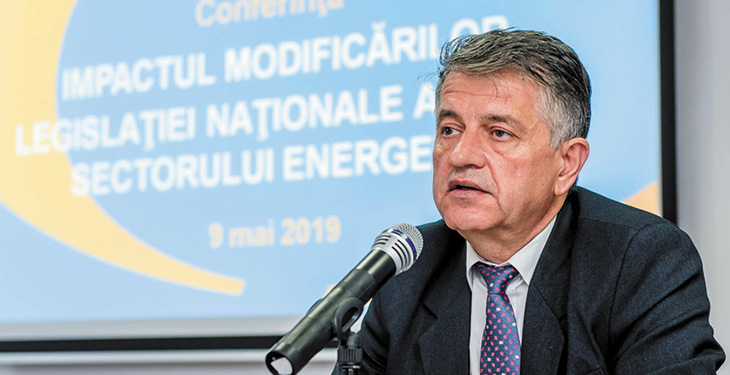The gas price has driven heating companies to the limit of survival, Doru Vișan, state secretary at the Ministry of Energy, told at a conference organized by CNR-CME. “Hence, the need to regulate gas and electricity prices,” he continued.
Last Autumn, the authorities have found that Romania has a 12,000 MW power generation capacity available, compared to the 20,000 MW figure previously considered. “Without any doubt, 8,000 MW were missing, a volume that influenced all the decisions that were made,” Vișan explained.
The government official turned then to the commercial issues, and stressed that the liberalization of the gas market has led to price increases. As a result of Romania’s natural gas production characteristics, we were confronted with a bipolar structure, which behaved on the „stair” principle, Vișan said. “When trading on the centralized market, one [of the two producers, e.n.] climbed one step, and the next transaction came not on that level, but climbed one more step. I cannot say whether it was intentional behavior or it was simply the result of the commercial deficit at the moment”, Vișan explained. This behavior led to prices of 130 lei per MWh, compared to the predictions of 70 lei per MWh.
In addition, there was the impact of the CO2 certificates. “From an estimated price of 7 euros per certificate, which was anticipated to climb to 14-15 euros, we had 27 euros per certificate, and then, in April, when the CE Oltenia fully assured its CO2 certificates needs, the price to be 23-24 euros per unit.”
In this context, the main power generator, CE Oltenia, sold its production at prices which internalized the cost of the certificates, and the other big producer, Hidroelectrica, immediately positioned itself right near the prices from CE Oltenia. Doru Vișan pointed out that, at the same time, Hidroelectrica has encountered an interval with low hydraulicity and it maintained its reserves in the big lakes to ensure system security. “It was an absolutely normal mechanism”, but it meant “we put in the market small volumes at high prices”.
The biggest impact has been transferred to heating companies, and thus they were driven near the limit of survival, because of the natural gas price. “They ended being lent by the natural gas suppliers, and local authorities could not afford the necessary subsidies and had not the financial resources to support this activity. This was the analysis that has led to the necessity to regulate gas and energy prices for a certain period of time, a practice also used by other powerful states in Europe”, concluded Doru Vișan.
What about the next Winter?
At present, all heating companies have their needs of natural gas covered, but the problems are still there. “Debt pressure still exists and it must be managed”, Vișan stressed, “first, step by step , for not transferring this burden entirely to the natural gas suppliers; the most important action is a national investment program in the cogeneration area which is absolutely mandatory”.
For the next cold season, however, the situation will be even more difficult to manage from the point of view of covering needs. “We have an almost exhausted producer, CE Hunedoara, where we can talk only about a social component, there are very small quantities of energy, but there are also major difficulties this producer has”, Doru Vișan summarized.
However, the worst problem is with CE Oltenia. Only 60% of the CO2 certificates were internalized in the market price, the rest was covered, with special efforts, by credits – 450 million lei, from 5-6 banks. “It was the maximum we could get, but it was not enough and we had to use the available loan in the market, and also the last funding reserve we had – the National Investment Plan, with the amounts related to the projects from Turceni and Ișalnița. It is impossible to believe that this will happen again, because we have nothing to guarantee with anymore”, Vișan warned. “We will have to bring this problem up to the Government and with all the other stakeholders involved to decide what we do with this company.”
The Secretary of State stressed that Romania should define the coal transition period, namely what is the time frame for the transition from coal-based to natural gas-based power generation, in correlation with the development of offshore capacities and also with the investment program – the time needed to develop such new investments. The Iernut plant will be completed on time in 2020, and in the same year the works at Deva (400 MW) will start, but this will not be enough, Vișan said. “It is imperative that we start a national cogeneration program in major cities, including Bucharest, Constanta, Timisoara, the industrial platforms in Craiova and Vâlcea, based on the new financing facility generated by the EU ETS Directive 410”, Doru Vișan asked.
Local authorities have not enough financial or organizational resources to deal with this issue by themselves, so there is a need to attract private investors. “Fortunately, there is a great deal of interest, so we have to offer that predictability to investors; the CfD mechanism is one of the targets we have assumed and which, I believe, will help attract the necessary investment”, concluded Doru Vișan.
Marginal price and adaptation to the market
Also present at the conference “Changes of National Legislation and their Impact on the Energy Sector”, organized by CNR-CME on May 9, at Politehnica University, in Bucharest, Sorin Alecu, Deputy Director for Development Strategy within Oltenia CE, brought to attention the effect of the marginal price on the electricity market. All evil began in 2000 with the organization of the energy sector on the basis of monofuel companies, he said. “The Romanian electricity market is not a competitive one, because it is based on the marginal price”, said Sorin Alecu. According to him, the prices obtained by the CE Oltenia from the market, excluding the revenues from system services or other revenues, have evolved from 173 lei per MWh in 2014 and 2015, to 171 lei per MWh in 2016, and 200 lei per year MWh in 2017.
“The effect of market resistance, namely demand, and not supply, makes it possible that, once the CO2 costs emerged, for example, CE Oltenia cannot recover the full costs from the market, while the margins of the other generators are considerably higher. Any tax on coal will increase the margins of all the other monofuel generators and will increase the cost of electricity to the final consumer”, said Sorin Alecu. “At present, in the current Romanian market context, the energy mix is made at suppliers’ level, and not at the producers’. So, the question arises: when our company will reconvert itself into a coal-free company (how we will do this is still to be identified!), who will have the marginal cost in the same market structure?” A question/warning that screams for reflection, because the generic answer is simple: each power generator should diversify its income sources, in a balanced structure. The practical answer – through investments and / or purchases – is much more complicated.
—————————————-
This article firstly appeared in the printed edition of energynomics.ro Magazine, issued in June 2019.
In order to receive the printed or electronic this issue of energynomics.ro Magazine, we encourage you to write us at office [at] energynomics.ro to include you in our distribution list. All previous editions are available HERE.

